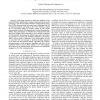295 search results - page 37 / 59 » Human-Computer Communication in Special Environments |
108
click to vote
HAPTICS
2003
IEEE
15 years 5 months ago
2003
IEEE
Haptic interfaces enable us to interact with virtual objects by sensing our actions and communicating them to a virtual environment. A haptic interface with force feedback capabil...
GLOBECOM
2007
IEEE
15 years 6 months ago
2007
IEEE
— Probe stations are specially instrumented nodes from where probes can be sent to monitor the network. Probe station locations affect probing efficiency, monitoring capability,...
CHI
2010
ACM
15 years 6 months ago
2010
ACM
Deictic reference – pointing at things during conversation – is ubiquitous in human communication, and should also be an important tool in distributed collaborative virtual en...
104
click to vote
ACMDIS
2010
ACM
14 years 12 months ago
2010
ACM
The design and use of Information and Communication Technology (ICT) has now evolved beyond its workplace origins to the wider public, expanding to people who live at the margins ...
GLOBECOM
2007
IEEE
15 years 6 months ago
2007
IEEE
— This paper proposes a directional medium access control (DMAC) algorithm for wireless communication networks operating in the 60 GHz bands. Wireless communications using the 60...

